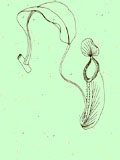
 |
Vertebrates (pdf)
Birds of Paradise in Irian Jaya, Indonesia
by Andy Cornish
In late July I visited the Raja Ampat Islands in Irian Jaya (also known as West Papua) to dive their superb coral reefs. On a day off (the Papuan staff were all Seventh Day Adventists and so do not work Saturdays), I took the opportunity the visit some nearby Birds of Paradise, birds that are mostly endemic to New Guinea. Wake-up was at 5 am and a boat sped me across the channel from our dive camp on Kri Island to the much larger Gam Island. A guide appeared out of the dark from the local village and led me by torch for a half hour trek up into the rainforest where a crude hide had been made 10 m up a tree looking over a traditional "display" tree for the Red Bird of Paradise (Paradisaea rubra). Males of this spectacular species are bright red apart from a dark green head, yellow neck and chest and have many long tail feathers including two elongate "wire" feathers. P. rubra is endemic to a small number of islands in western Irian Jaya and there are conservation concerns about it due to hunting for skins (the feathers are used in traditional costumes) and habitat degradation, according to Birdlife International (www.birdlife.net). Three males were present as dawn broke, periodically their squawks would increase in frequency and they would fly up to some large, leafless branches at the top of the tree and above the forest canopy, extend their wings and swoop back a perch several metres below. This went on for 20 minutes and I wasnít terribly impressed. The birds were a good 10 m away and above so I could see little more than a small silhouette, even through the zoom on my camera. Worse, the mosquitos had discovered me.
I looked down to the forest floor expecting my guide to be thoroughly bored and was gobsmacked to find him watching the birds with a pair of decent Olympus 7x binoculars I hadnít noticed previously. I borrowed these off him and just in time, as the sun hit the top of the canopy and the true beauty of the birds became apparent, three more males appeared and the contest to attract the ladies reached a new intensity. Their efforts werenít wasted as within minutes, one and then another of the drab females landed in the tree. The males were visibly excited but the rules of courtship appeared to be that the female had to make the first move, even after one of the females liked what she saw, and hopped up to one of them. He started swaying from side to side in front of her and things seemed to be going well but they disappeared behind some foliage and it was impossible to say whether copulation took place. On the way back later we also saw Blythís hornbill (Rhyticeros plicatus), Eclectus parrot (Eclectus roratus) and Sulphur crested cockatoo (Cacatua galerita). HK$ 50 for the guide may not seem much but it is more than a weeks wages for many Indonesians and counters the money to be made from killing the birds for island villagers who have virtually no other sources of income.
|
|
P.11 |
|
Porcupine! |
 Copyright © 2000 |
